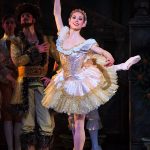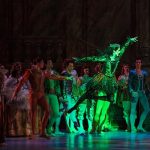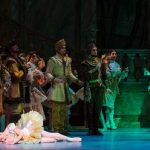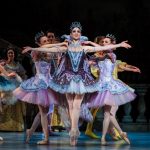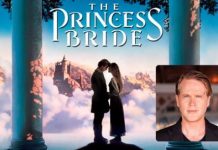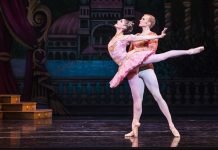
SALT LAKE CITY, Utah, Feb. 21, 2017 (Gephardt Daily) — In a world that often can seem dark, Ballet West’s “The Sleeping Beauty” is a welcome beacon of light and joy.
A timeless fairy tale and finely polished, technically demanding choreography combine with Tchaikovsky’s score as Ballet West awakens Adam Sklute’s production at the Janet Quinney Lawson Capitol Theatre, continuing through Feb. 26.
Reconceived and produced by CEO and artistic director Sklute in 2011, “The Sleeping Beauty” this year showcases a cast of more than 130 backed by the 65-piece Ballet West orchestra. It is one of the largest productions in the company’s repertoire, and the tale of love it weaves is perfect for the month of Valentine’s and the coming springtime.
The story is taken from Charles Perrault’s fairy tale, and begins with the christening of the Princess Aurora. All the fairies have been invited to attend the ceremony except for the ill-natured Fairy of Jealousy, Carabosse. In Carabosse’s anger, she presents the child with a spindle and foretells that one day, Aurora will prick her finger and die.
But the Fairy of Wisdom, the Lilac Fairy, as her gift to the baby princess, changes Carabosse’s curse. When Aurora turns 16 and pricks her finger, instead of dying, she falls into deep sleep, along with the entire royal court. One hundred years later, Prince Desire is led to the sleeping princess’s castle by the fairies and breaks the spell by kissing Aurora.
The primary adjective I would use to describe this two-and-a-half hour, three-act ballet is sumptuous. Sklute said in a news release his driving force with “The Sleeping Beauty” has always been to make it both engaging for children and meaningful for adults, and to satisfy those patrons who know the art form well and be accessible to the novice ballet goer (I am, quite admittedly, the latter).
That, certainly, is achieved.
The child in most of us cannot fail to be excited by the visual opulence of the production. The costumes of the fairies, for example, are splendid Easter-egg colored confections for all of us that dreamed of being either a ballerina, or a sprite, or both, when we were little (and really, who didn’t?) The sets are depicted (mostly by drops and scrims) with a combination of realism and a sort of pleasing, Renaissance-style quality. Both set and costumes for this production are by Peter Cazalet.
The lighting design by Kevin Dreyer also reinforces the well thought out color palettes of the production — for example, during the scenes featuring Carabosse, intense green washes are used to both heighten the drama and enhance the themes of each scene.
The performances the night I saw the production (opening night) were absolutely finely honed. Aurora was depicted by principal Katherine Lawrence, who has an interesting dynamic as a dancer I very much enjoy. She’s a strong, athletic performer, which is absolutely necessary for this extremely demanding role. But she also has an ethereal youthfulness about her, which makes her perfect for Ballet West roles like Aurora, who at times in the play is only 16 years old, and Juliet in “Romeo and Juliet,” who of course in Shakespeare’s script is just 13 years old. Lawrence was ably paired with first soloist Adrian Fry.
I was also lucky opening night to catch first soloist Allison DeBona as Carabosse. DeBona has a rangy, languid edginess about her that is perfectly suited to this scene-chomping role. It’s also really obvious that DeBona is having a whale of a time, getting to fly, and eventually disappear in a dramatic fashion, which I won’t give away.
I also really enjoy watching principal Emily Adams, who has a commanding, earthy presence as the Lilac Fairy. Adams pretty much has to ground the show; she is front and/or center in much of the staging, and she achieves this beautifully. Interestingly, Tchaikovsky’s score has two musical themes that represent good (Lilac Fairy) and evil (Carabosse), and they repeat whenever the respective character is on stage.
I would have liked to have gone back to the ballet again to see principal Beckanne Sisk in the role of Aurora or the Lilac Fairy, although honestly, she has the X-factor in whatever role she plays, which on opening night was the peppy, scene-stealing Countess. The production also unfortunately does not feature principal Christopher Ruud, as he is out for surgery, and that is a pity; his presence is missed.
“The Sleeping Beauty” plays at the Capitol Theatre at 7:30 p.m. on Feb. 23 and 24 and at 2 p.m. Feb. 26. Tickets are $20 to $97 and are available by calling 801-869-6920, or online here. The Capitol Theatre is at 50 W. 200 South.

